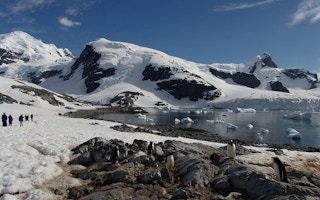The South Pole is warming, and warming fast. In the last 30 years, the place furthest from the summer sun, the place where one winter’s night lasts for 179 days, has been warming at 0.6°C per decade. This is three times the speed of average warming for the whole planet.
The finding is unexpected. The geographic South Pole is not only the most extreme location in the southern hemisphere, it is also at Alpine altitude. The Amundsen-Scott research station at the pole is at 2,835 metres, perched on a sheet of glacier ice 2,700 metres above the bedrock, and moving towards the sea at 10 metres a year.
Winter temperatures have fallen to minus 82.8°C. The warmest summer day ever recorded was minus 13.6°C.
And yet this unforgiving spot, with an annual average temperature of minus 49°C, still registers a measure of global warming. Whether this warming is fuelled by a natural climate cycle or by the profligate human use of fossil fuels, or by both, is not certain.
Systematic record-keeping began only in 1957 and for most of the late 20th century, while the rest of the planet started to warm, the South Pole continued to cool. West Antarctica is getting warmer, and melting at an accelerating rate, thanks in part to human-fuelled climate change.
But scientists from New Zealand and the US report in the journal Nature that between 1989 and 2018, the South Pole had warmed by 1.8°C, partly because warm waters in the western Pacific had affected the South Atlantic winds and stepped up the delivery of warm air to the heart of the continent.
And this most extreme of environments goes on presenting puzzles. In April researchers announced the discovery of the remains of a 90-million-year-old swampy temperate forest within 900kms of the South Pole: it was once so warm that even in a winter night that lasted for months, foliage could flourish.
The latest research from the South Pole data suggests that researchers would like to know a lot more before they can say if the warming trend will continue, and why.
“Antarctica experiences some of the most extreme weather and variability on the planet,” said Kyle Clem, of Victoria University in Wellington, New Zealand, who led the research, “and due to its remote location we actually know very little about the continent, so there are constant surprises and new things to learn about Antarctica every year.”
This story was published with permission from Climate News Network.










